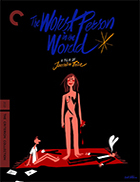The Worst Person in the World (Verdens verste menneske)
|  Joachim Trier’s The Worst Person in the World (Verdens verste menneske) would seem to be a very different film from his most recent, the moody horror-drama Thelma (2017), which follows a college freshman whose introduction to the secular world unleashes both her repressed sexuality and her repressed paranormal abilities. The two films exist in very different worlds tonally—Thelma is all mood and atmosphere, while The Worst Person the World is purposefully banal except when diving into fantastical dreams and daydreams—but they are essentially about the same thing: a young woman figuring out who she is and where she belongs. They are both coming-of-age tales grounded in distinct genres (horror and romantic comedy, respectively). The Worst Person in the World is the more challenging of the two in that Julie, the protagonist, rather than being a victim of imposed repression through her strict religious upbringing, is instead a privileged young woman who often squanders her own agency by flitting from one thing to another, whether it be careers or men. Julie is played by Renate Reinsve, who made her debut in a small role in Trier’s sophomore feature Oslo, August 31st (2011) and won the Best Actress award at Cannes for her work here. She has a tricky role to play, as Julie is a mix of selfishness and lack of self-awareness; profoundly gifted in many ways, she is given to sudden changes in focus and interest (when we first meet her, she is in medical school, but she soon loses interest and turns to psychology and then photography). She is casually amoral in her lifestyle; unlike the titular character in Thelma, she seems completely unmoored from any moral worldview outside of whatever happens to be engaging her in that particular moment. And, while there is a genuine risk that these characteristics will seem shallow and irritating in her capriciousness, Reinsve grounds the character in a sense of genuine (but not neurotic) instability that we can understand, even if it sometimes makes her disagreeable. One of the most powerful moments in the film, in fact, finds her turning in sudden anger on her boyfriend when he is genuinely attempting to compliment her; it is a moment of raw honesty about the way emotions can turn on a dime and how old wounds can poison current interactions. In a nod to Jean-Luc Godard’s Vivre sa vie (Her Life to Live, 1962), which was subtitled Film en douze tableaux (A Film in 12 Tableaux), The Worst Person in the World is divided into 12 chapters, although Trier’s structure is more about charting Julie’s highs and lows, whereas Godard’s film was a slow downward trajectory. Much of the film centers around Julie’s relationship with two men: Aksel (Anders Danielsen Lie), the author and illustrator of a subversive comic book series that is being adapted into a sanitized movie, and Eivind (Herbert Nordrum), a shy barista who she meets at a party while she is still living with Aksel. The two men are very different in many ways (although they both share a kind of goofy-funny handsomeness), which makes them into reflections of Julie’s competing desires for adventure and comfort, danger and conformity, togetherness and isolation. One of the film’s real strengths is the way it depicts the everyday in’s and out’s of long-term relationships and what is both great and taxing about them (the aforementioned scene in which Julie loses it on Eivind when he compliments her writing is telling in this regard). The banality of everyday life is punctured throughout the film with excursions into Julie’s subconscious, which Trier treats like mini-movies of widely different styles. So, for example, when Julie falls in love with Eivind, the blissed-out, all-consuming nature of her infatuation is visualized by the whole world coming to a stop as she leaves the apartment she shares with Aksel and runs through the streets to him, seemingly free of any and all burdens, which makes it both a reflection of her emotional state and a foreshadowing of how the initial explosion of romantic love can blot out reality, but only for so long. In a completely different scene, Julie takes magic mushrooms with Eivind and some friends and finds herself descending in a hallucinogenic netherworld that is haunted by very literal fears of aging and dying. Trier, who cowrote the screenplay with his regular collaborator Eskil Vogt, clearly wants to capture both the mundanity of everyday life and the vividness of Julie’s internal world, and he is mostly successful in capturing that duality. Reinsve’s performance is central to making the film work, as everything hinges on our ability to empathize with Julie, even when she is at her worst (although the film’s title comes from a line spoken by another character about himself, not her). The Worst Person in the World is not a perfect film, especially in the third act where Trier pulls out a major illness to keep characters in each other’s orbits, but it still works as a deft portrait of an unsettled life.
Copyright © 2022 James Kendrick Thoughts? E-mail James Kendrick All images copyright © The Criterion Collection | |||||||||||||||||||||||||||||
Overall Rating: 


 (3.5)
(3.5)


